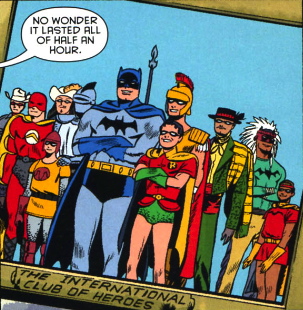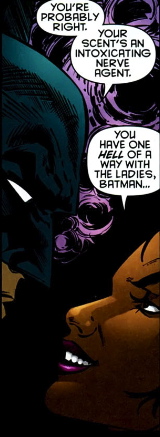Note: I am reprinting, without change, a series on Grant Morrison’s Batman work originally printed in 2013 on my old site.

Most Grant Morrison fans will say that Frank Quietly is the best Morrison artist, and I would have agreed before I read “Club of Heroes,” which is reprinted in the trade, Batman: The Black Glove, illustrated by JH Williams III. This story is where the Morrison Batverse starts to get really, really diverse and weird…

Club of Heroes is short, quick and fun: A rollercoaster ride that can be read even if you haven’t read all that came before.
From the get-go, this is clearly an important story in Morrison’s overall Bat-epic. On page one, we see a man (we later know it’s Mayhew, the man who called the club of heroes together) hanging upside down (recalling the possible future death of Professor Pyg Batman #666); we’ve got the red-and-black checkerboard, which appears throughout the five-plus year Batstory (but there’s never a very clear reason for it); Black Glove is talking grandiose (but we don’t see his face, or who he’s talking to); and the narrative if focused on good versus evil.

The tale is like an Agatha Christie locked room mystery: Batman, and a bunch of lesser Batman types, are trapped in a house by The Black Glove (although Batman still doesn’t know much about who that villain really is), and one by one they are picked off. The idea that Batman could form his own Justice League made up almost entirely of Batmen forms the basis for the later Batman, Inc. story—and also brings to mind Batman’s suspicion of Superman in Frank Miller’s Dark Knight saga.
Just about every one of the odd characters in this story is from the Silver Age: John Mayhew and the Club of Heroes were actually called The Batmen of All Nations, way back in 1955.
Even though it’s weird and it plants lots of seeds for the coming stories, Club of Heroes is easy to read as a standalone story. As the Morrison stories get deeper, they can be read on two levels: As a freestanding Batman tales, or as part of a larger, greater whole. And as they get even farther along, they move along that spectrum until you hit Batman: R.I.P., which makes zero sense if you haven’t read what came before.
Although it can be read on its own as a great story (one of Morrison’s best, in fact), it also can be read as one giant foreshadow: A millionaire is destroyed and his identity is overtaken (literally, as Mayhew’s killer wears the dead playboy’s skin), and sidekicks take on their mentor’s roles, if not their actual mantles. As we all know, Dick Grayson will later wear Batman’s “skin” and Damian Wayne will take on the Robin identity full-time. A larger group of Batman-like operatives come together for a greater good, and later we’ll see this again in Batman, Inc. Batman is locked in a house with his enemy, as he gets locked in with Joker during Batman R.I.P.
We also learn that “The Black Glove” was an old movie from the 1920s. It’s not clear why Batman’s enemy, the man who is manipulating this entire epic, named himself after the film (in fact, that is never made clear), but it’s another hint from Morrison that something bigger than just a Batman murder mystery is going on here.
Cute fun fact: The second issue in this arc is titled “Now We Are Dead,” which recalls A.A. Milne’s “Now We Are Six.” And there were six Batman/Robin teams involved in this mystery.
We also see Batman being exposed to an intoxicant again. He’s constantly being drugged throughout this epic—every single story involves him being exposed to some agent or another—all as part of Black Glove’s gradual plan to drive Batman insane.
NEXT: The Resurrection of Ra’s Al Ghul.

